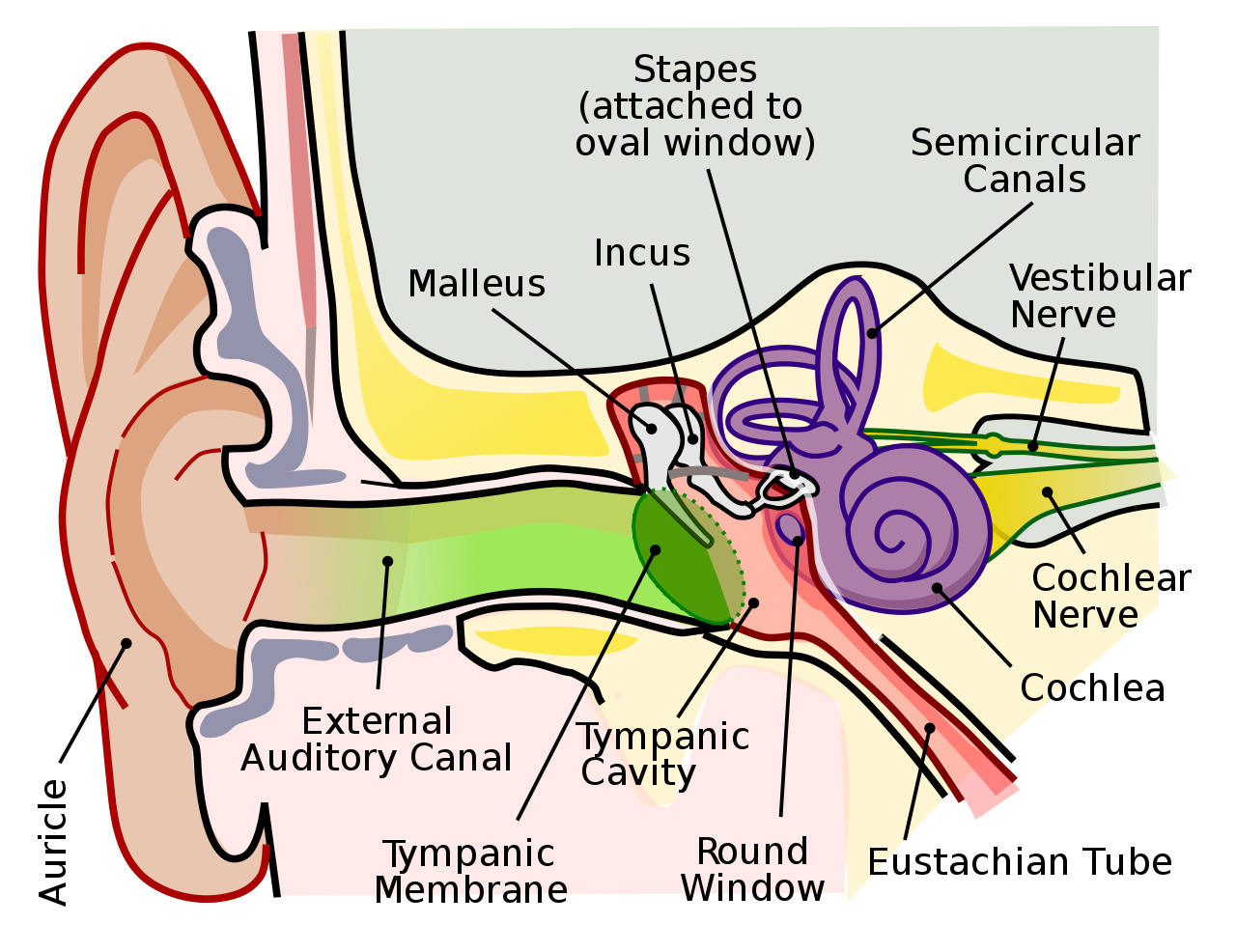Noise
Noise is any annoying, disturbing or unwanted sound. Noise can have many effects on people. It can: irritate people, interfere with verbal communication, reduce working efficiency, disturb sleep or even damage hearing.
Characteristics of noise
Where does noise come from? Almost every aspect of modern life generates noise – industrial processes, construction, office work and even home and leisure activities. Industrial production and construction are rapidly increasing in many countries and this brings with it an increase in industrial or ‘occupational’ noise. If we expose ourselves to extreme noise levels, then damage to our hearing can easily occur. Ultimately this could lead to severe deafness and to exclusion and isolation from society. Therefore, it is essential that we take good care of our hearing.
Frequency
Frequency is the number of times that the air is compressed and decompressed in a second, and is measured in cycles per second, or Hertz (Hz). Low frequency produces a low pitched, bass sound. High frequency produces a high pitched, whistle sound. Human ears respond to frequencies between 20Hz and 20,000Hz. The human voice produces frequencies between 500Hz and 2,000Hz. Below 20Hz and above 20,000 Hz sound cannot be heard but it can still be harmful. The ear is most sensitive to sounds between 1000 and 4000Hz.


They are pure tones or sine waves. The last sound increases from 20Hz to 20,000Hz and is called a ‘swept sine wave’.
500Hz
2,000Hz
20-20,000Hz
Intensity
Some noise intensity measurements are given in a measure called ‘dB(A)’ which takes into account the frequency sensitivity of the ear. dB(A) measurements are obtained on a noise meter which weights the different frequency components. For example, the noise intensity for a circular saw, and the noise intensity inside a bus have the same value when expressed in dBs but the noise from a circular saw contains a greater proportion of high frequencies, and is more annoying than the noise inside a bus. Therefore, the circular saw has a higher dB(A) value.
Some examples of noise levels are shown below.
| Decibels (dB(A)) | Exposure level | Common noise sources |
| 140 | Harmful to hearing | Jet engine 25m away; Shotgun blast |
| 130 | Threshold of pain | Jet takeoff 100m away |
| 120 | Disco; Propeller aircraft | |
| 110 | Possible hearing loss | Live band; Jet takeoff 600m away |
| 100 | Electric mower; Pneumatic drill; Tractor | |
| 90 | Open top car ride on motorway; Food blender; Heavy traffic 5m away | |
| 80 | Very noisy | Alarm clock; Sink garbage disposal |
| 70 | Upper limit for hearing conversation | Vacuum cleaner; Private car |
| 60 | Conversation at 1m; Singing birds | |
| 50 | Quiet | Light traffic 30m away; Quiet office |
| 40 | Dripping tap; Library | |
| 30 | Very quiet | Soft whisper at 5m |
| 20 | Broadcasting studio | |
| 10 | Leaves rustling | |
| 0 | Threshold of hearing |
Legal requirements for noise
In the UK, the Noise at Work Regulations limit the noise to which an employer can expose the employees. It is based on three Action Levels:
- First Action Level: 85dB(A) for 8 hours per day. Employees can demand hearing protection.
- Second Action Level: 90dB(A) for 8 hours per day. Employees must wear suitable hearing protection.
- Peak Action Level: 140dB(A). This must never be exceeded.
If workers are exposed to noise for more than 8 hours per day, these levels must be reduced. Conversely, if workers are exposed to noise greater than these levels, then the duration of their exposure to the noise must be reduced.
Anatomy of hearing
A sensation of hearing is caused when sound waves pass through the ear passage, resulting in the vibration of the eardrum. This, in turn, activates a lever system of three small bones – the hammer (malleus), the anvil (incus) and the stirrup (stapes), situated in the air-filled cavity of the middle ear. The stirrup sets up vibrations in the fluid-filled inner ear and the mechanical vibrations are transformed into nervous impulses, which travel to the auditory cortex in the brain and are recognised as sound.

Why does your voice sound different on a tape recording?
How can you tell the direction of a sound?
The effects of noise
Deafness
The main effect of noise is the development of deafness, especially when you are exposed to high levels of continuous noise, for example, during working hours. This may result in ‘noise-induced occupational deafness’. There is no cure and no treatment for deafness. Damage to your hearing is permanent, and will never get better.
Occupational deafness is a gradual process of reduction of hearing ability associated with damage to the cochlea. Occupational deafness does not occur accidentally; it is a result of not reducing exposure to noise, for example, by moving out of a noisy environment or wearing hearing protection. The initial loss of hearing occurs at frequencies above those involved in speech (500-2,000Hz) and consequently considerable loss can occur before the effect becomes noticeable to you. The obvious danger is that considerable damage may have occurred to the hearing mechanism before you become aware of it, and in later life, this deafness will become worse because of the natural effects of the aging processes.
Noise and performance
Noise causes fatigue and loss of concentration and efficiency, resulting in a decrease in work output and an increase in the number of mistakes made. Work involving learning is more susceptible to disruption from noise than routine work. This could be of importance to a school leaver training on-the-job in a noisy work environment.
Speech comprehension
The comprehension of speech is affected by both the sound level of the background noise and the sound level of the voice itself. The average intensity of a human voice in a room at a distance of one metre lies within the following ranges:
Conversation 60-65dB(A)
Dictation 65-70dB(A)
Calling out 80-85dB(A)
The general background noise level must be at least 10dB(A) below these levels if the sound of the voice is to be heard clearly.
Guidelines for noise levels
Many leisure activities have become major sources of noise and hazards to hearing. Levels in night clubs can exceed 100dB(A). Most visitors are exposed to this only for a few hours per week, but DJs, musicians, bar and security staff are working in this all the time and may be at risk of damage to their hearing.
The World Health Organisation (WHO) provides some guidance on acceptable levels of noise in the community.
| Specific environment | Health effects | Target level (dB(A)) |
| Outdoor living area | Serious annoyance, daytime and evening | 55 |
| Moderate annoyance, daytime and evening | 50 | |
| Indoor living area | Speech intelligibility and moderate annoyance, daytime and evening | 35 |
| Inside bedrooms or hospital ward rooms | Sleep disturbance, night time | 30 |
| Outside bedrooms | Sleep disturbance (window open) | 45 |
| School classrooms | Speech intelligibility, disturbance of information extraction, message communication | 35 |
| Hospital treatment rooms | Interference with rest and recovery | as low as possible |
| Industrial, commercial, shopping and traffic areas | Hearing impairment | 70 |
| Ceremonies, festivals and entertainment events | Hearing impairment | 100 |
| Public address | Hearing impairment | 85 |
| Music through headphones | Hearing impairment | 85 |
